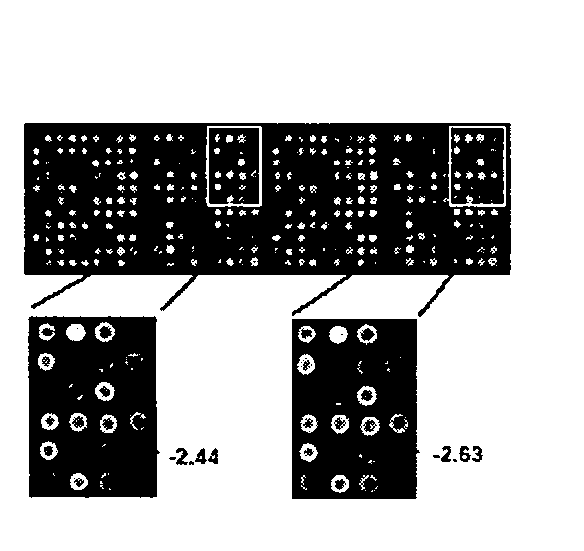Method for detecting gastric cancer by detecting VLDLR gene
a gastric cancer and gene technology, applied in combinational chemistry, biochemistry apparatus and processes, library screening, etc., can solve the problems of not being applied, not elucidating the form of such genetic alterations that induce gastric tissue cell malignant transformation, and not being able to detect gastric cancer or examine the malignancy of gastric cancer. achieve high stability
- Summary
- Abstract
- Description
- Claims
- Application Information
AI Technical Summary
Benefits of technology
Problems solved by technology
Method used
Image
Examples
example 1
[0044]With the use of genome database websites of the National Cancer for Biotechnology Information and the University of California Santa Cruz Biotechnology and results of BLAST searches concerning selected DNAs, 800 different BAC / PAC clones each having a gene playing a important role in malignant transformation and cancer cell growth or a sequence tagged site marker were selected.
[0045]BAC and PAC DNAs were digested with DpnI, RsaI, and HaeIII, followed by ligation with adapter DNAs. Next, PCR was performed twice with the use of primers having the sequences of the adapters. One end of the pairs of primers had an aminated 5′ end. This process is referred to as “infinite amplification.” The thus obtained DNAs are defined as “DNAs obtained by infinite amplification.” DNAs obtained by infinite amplification were printed in duplicate on an Oligo-DNA Microarray (Matsunami Glass; Osaka, Japan) with the use of an inkjet spotter (GENESHOT, NGK INSULATORS; Nagoya, Japan) such that they were...
example 2
[0046]In order to detect a novel homozygous deletion in the case of gastric cancer, CGH array analysis was carried out with the use of genomic DNAs prepared from 32 different gastric cancer cells and the CGH array of Example 1.
[0047]In addition, genomic DNAs of healthy male volunteers were labeled with Cy5 so as to be used as controls. Genomic DNAs prepared from the aforementioned gastric cancer cells were labeled with Cy3 so as to be used as test sample DNAs. Specifically, genomic DNAs (0.5 μg each) digested with DpnI were labeled by nick translation in the presence of 0.2 mM dATP, 0.2 mM dTTP, 0.2 mM dGTP, 0.1 mM dCTP, and 0.4 mM Cy3-dCTP (used for gastric cancer cells) or 0.4 mM Cy5-dCTP (used for normal cells). Cy3- and Cy5-dCTPs were obtained from Amersham Biosciences (Tokyo, Japan). Both labeled genomic DNAs were precipitated in the presence of Cot-1DNA (Invitrogen) with the addition of ethanol. The resultant was dissolved into 120 μl of a hybridization mixture (50% formamide,...
example 3
[0050]Two types of primers were designed based on the sequence of the human VLDLR gene in the gastric cancer cells. mRNAs derived from both primer regions were detected by RT-PCR.
[0051]As a result, it was impossible to detect mRNAs derived from cell lines in which homozygous deletion was observed. Further, RT-PCR products were not detected from 9 cell lines in which homozygous deletion was not observed (among 32 cell lines). In the cases of 7 cell lines, the expression level obviously decreased compared with normal gastric tissue. [FIG. 2B shows results of RT-PCR analysis for detection of the human VLDLR expression in gastric cancer cells. In FIG. 2A, cell lines in which homozygous deletion was observed are indicated by arrows in a similar manner. In 9 cell lines in which homozygous deletion was not observed (among 31 cell lines), the human VLDLR mRNA expression disappeared at a frequency of 29.0% and the expression level decreased at a frequency of 22.6%.] Thus, in addition to gene...
PUM
| Property | Measurement | Unit |
|---|---|---|
| concentration | aaaaa | aaaaa |
| concentration | aaaaa | aaaaa |
| diameter | aaaaa | aaaaa |
Abstract
Description
Claims
Application Information
 Login to View More
Login to View More - R&D
- Intellectual Property
- Life Sciences
- Materials
- Tech Scout
- Unparalleled Data Quality
- Higher Quality Content
- 60% Fewer Hallucinations
Browse by: Latest US Patents, China's latest patents, Technical Efficacy Thesaurus, Application Domain, Technology Topic, Popular Technical Reports.
© 2025 PatSnap. All rights reserved.Legal|Privacy policy|Modern Slavery Act Transparency Statement|Sitemap|About US| Contact US: help@patsnap.com



